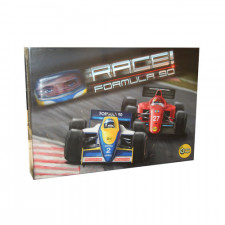Race! Formula 90 Review
on Jan 6, 2016
Sports games have a hard time on the tabletop, with auto racing (yes, I know, it's a motorsport; they wouldn't complete nearly as many laps without the car) being one of the few exceptions, and race game makers have long sought to create that perfect marriage of Euro strategy and American white-knuckle excitement with mixed results, until finally in 2013, Allesandro Lala's Race! Formula 90 worked its way through the crowded field, downshifted, cut to the inside and broke away from the pack.
I enjoy a good strategy session as much as the next gamer, but the heart of a race game for me is the action. As much as plastic and cardboard can, I want to feel like I'm in the cockpit, straining to hold my line in a tight turn or waiting a beat longer to brake so I can shoot past another car while keeping my machine out of the wall. I tried Dr. Knizia's race game Formula Motor Sport, which, like most of his inventions, has stellar strategy and a pasted-on theme, so I moved on to Formula De. It had quality components and interesting strategy, but the finishes were ultimately up to the dice. This led me to Bolide, which held my attention for a long time once I found all of the necessary rules fixes thanks to its brilliant (if borrowed) simulation of physics on the tabletop. Great for a single race; almost useless for a career. Then came Race! Formula 90.
Up to six players, plus another half-dozen "robot" cars give the feel of an actual race field at all player counts. Keeping track of tire wear, car damage and laps left until the next pit stop add planning to the action, with strategies, driver abilities and weather conditions upping the simulation even further. But how does it feel?
Players manage a hand of cards to move their car around the track, each one having a distance, a check value and one or more consequences for its use, so it's a balance between speed and car wear each turn. The planning's there, but the action felt lacking at first. Similar to Formula De, the track declared which sections required a slow-down or a premature halt if other cars are present, waving large warning signs in drivers' faces instead of offering subtle perspective shifts they might not recognize until they're too deep in the turn. Certain spaces contain trajectories, multi-colored paths through corners offering bonuses for the car that ends its move at their start and plays a matching color card on its next turn. As we played, I accepted what I saw and resigned myself to a strategic game, and then the action snuck up on me as I came out of turn five at Monza.
I could redline my engine, playing two cards and roaring ahead five spaces and leaving black rubber streaks on the asphalt, but if I played a single, slower card I'd end my move on turn six's trajectory and get a bonus to my next move. Using a faster card there would put me at turn seven's bonus trajectory, allowing me to shoot through the final turns and onto the front straight at high speed. I sat back and marveled for a moment, smiling; the track, rules and card system allowed me to slow down, set up my line through the corners and save tire wear by avoiding hard turns at high speed. The action's there, almost hidden in plain sight, waiting for the smart racer to spot it- and that's a sign of a great game.
Another sign: multiple levels of gameplay. Race! Formula 90 is as enjoyable with a table full of serious strategists using the game's advanced rules to build their own cars, customize their driver's skills and plan for a possible change from rain to sunshine mid-race as it was sitting around the kitchen table with my family after Christmas dinner and zipping around the track using basic rules. Whether your opponent asks, "is it more like set-collection or hand management?" or, "is it more like Monopoly or Risk?" this game can provide an evening of fun and excitement.
Why a great game, and not the perfect race game? With 184 cards in the deck, it's possible to have the action and strategy derailed by a bad draw, taking me out of the cockpit and back to the table for a turn or two. Extensive rules and colorful symbology on both the cards and track can be daunting at first, but flow easily after a few plays, and the last stretch required by racers is the way time passes in the game.
Each game turn represents anywhere from one to three laps of the race, with the cars' positions seen as snapshots in television coverage, if you will. Or even if you won't, you have to because that's the way it works, and it can feel a bit off to have the race end with the leader in the middle of turn two instead of roaring across the finish line. But these are minor offenses in an excellent experience, and quickly fade with each contest, leaving Race! Formula 90 firmly in the lead and pulling away from the race game pack. This driver thinks it'll hold its lead for quite some time.

 Customer Support
Customer Support  Subscribe
Subscribe 




 Account
Account  Wishlist
Wishlist 

